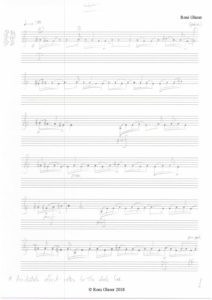Here’s me practising the piece I’m working on right now.
It’s only the beginning, just so you can hear a little bit and get an idea what it sounds like. And it’s as far as I’ve managed to learn how to play, complete with fluff-ups. It could probably go a couple of clicks faster too.
You can find the first draft of the score here if you missed it last week.

What you hear here essentially comes from the first 25 seconds of what you heard in last week’s video. You’ll hear what the other 16 seconds have turned into in a later post – when I’ve learnt to play it.
Contents
Context of this preview within the piece
What you hear is probably about a third of the whole of this second movement. Structurally, it’s basically a first theme, a transition, a second theme, a transition, and then right at the end there’s a return to the first theme, although modified.
Learning the piece
Since learning this piece is not easy, I’d like to talk about how I’m learning it, and maybe help anyone else who might want to do me the great honour of having a go at playing it.
Technical aspects
The piece is actually technically pretty simple, I haven’t really used any very difficult chord shapes or big stretches (well, not too many), and there aren’t any really fast scales.
The hardest aspects
Confusion and spinning out
The technical side of things is not exactly easy, but the hardest thing I’ve found is mentally coordinating each tiny element of the piece.
Many passages use few different pitches, but played on different strings with different articulations – plucked, hammered-on or pulled-off. With limited variation in pitches, this means you’re playing similar things in different ways, and it’s easy to get confused about what goes where.
When practising a passage, you make a mistake, try again, make a mistake, try again, all the while with quite similar sounding notes ringing in your ears. This can be a bit of a spin-out. I’ve often had to stop and have a few seconds of silence to reset and re-centre myself, as it were, before carrying on.
After a while the confusion passes, and I’ve found that after a while you get the sense of the flow of the music and it comes through the fingers more naturally. It is taking me some practice though.
Pain, blisters and callouses
The right-hand thumb plays an essential, as well as loud, role in this piece. The flesh just under the side of the nail does take bit of a beating. A bit of pain never did anyone any harm, but I suggest stopping before you get a blister so the callous can form properly. Nice. I’ve decided to spare you pictures.
Because there are a lot of forceful ligados (hammer-ons and pull-offs), the left-hand index finger gets pressed against the strings in ways that can hurt a bit while practising. You get used to it. I reckon players who are more careful than me won’t get this problem as much though.
Interpretation of the piece
There is no room for interpretation! I play the piece exactly as the composer intended. Well, of course I would if I could play it properly. Hopefully with some more practice. You might have other ideas though, and that’s cool. Just make sure the character of the music is there.
I do, however, have the opposite problem, which is that I need to make the character clear in the notes. I haven’t used many words in this first draft, except the Italian brutale towards the end. That’ll take some more thinking.
Next time
Next time I’ll explain some more theoretical stuff on how I’ve made the piece – how I’ve designed the melody, and harmonic aspects and their close relationship to the guitar. Let me know what you think!
